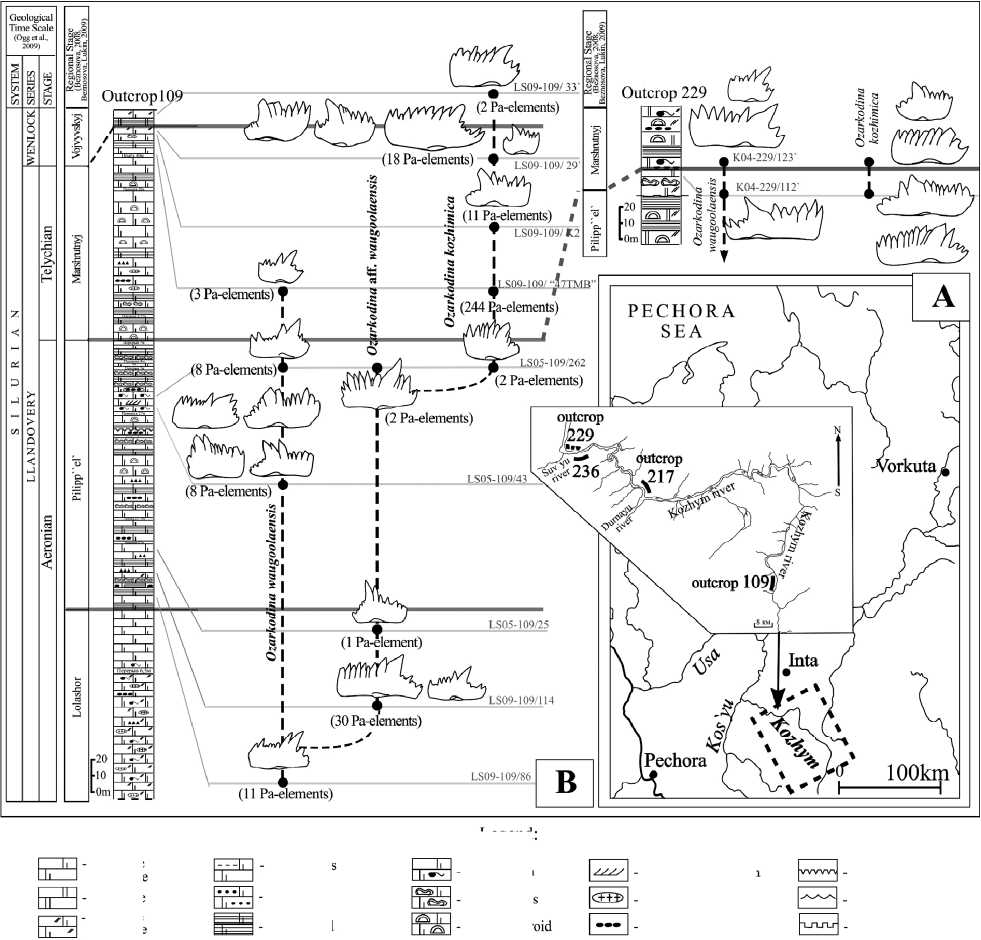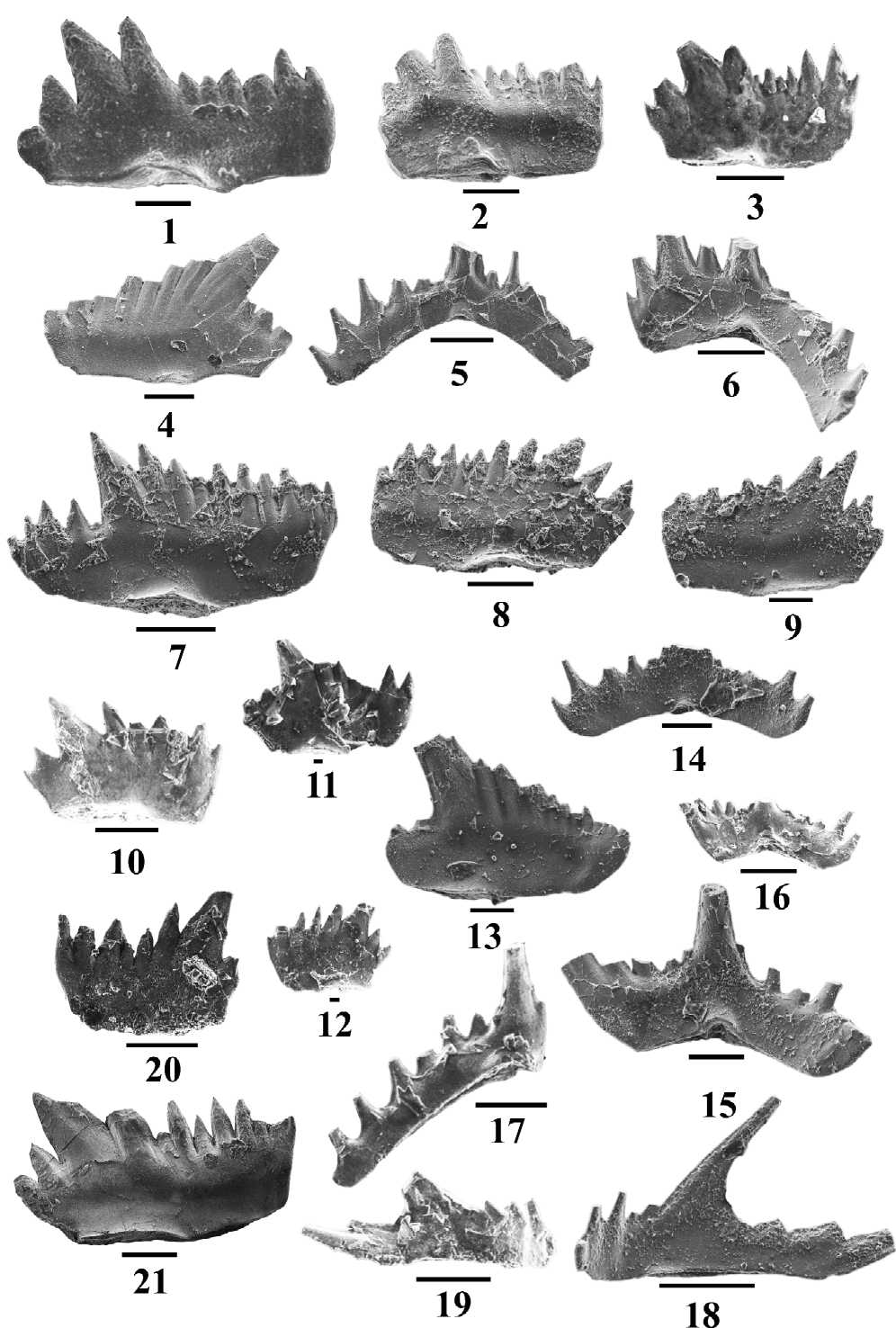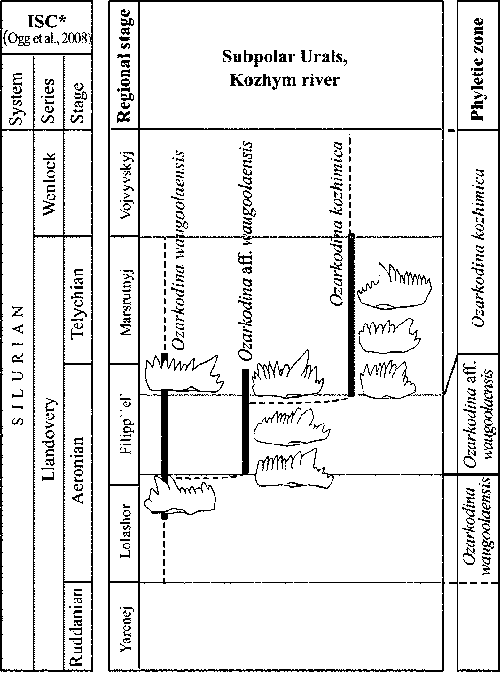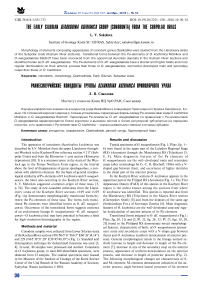Раннесилурийские конодонты группы Ozarkodina kozhimica Приполярного Урала
Автор: Соколова Л.В.
Журнал: Вестник геонаук @vestnik-geo
Рубрика: Научные статьи
Статья в выпуске: 10 (286), 2018 года.
Бесплатный доступ
Изучена морфология элементов конодонтов рода Ozarkodina из лландовери Приполярного Урала в бассейне р. Кожым. Из отложений верхнего аэрона р. Кожым установлены переходные формы между Ра-элементами вида O. kozhimica Melnikov и O. waugoolaensis Bischoff. Переходные Ра-элементы O. aff. waugoolaensis по сравнению с Ра-элементами O. waugoolaensis характеризуются более коротким и высоким листом и более регулярной зубчатостью на переднем отростке, а по сравнению с Ра-элементами O. kozhimica - хорошо развитыми главным и вторым зубцами.
Конодонты, морфология, ранний силур, приполярный урал
Короткий адрес: https://sciup.org/149129278
IDR: 149129278 | УДК: 56.016.3;551.733 | DOI: 10.19110/2221-1381-2018-10-30-34
Текст научной статьи Раннесилурийские конодонты группы Ozarkodina kozhimica Приполярного Урала
The apparatus of conodonts Ozarkodina kozhimica was described by S.V. Melnikov from the upper Llandovery throughout Wenlock in the Kozhym River reference section # 217 (Subpolar Urals) and from the Khoreyver-1 core section (Khoreyver depression) [10]. It is a common taxon in the strata of the Wen-lock age in the Timan-Northern Urals region, in the interval above the level of disappearance of genus Apsidognathus , a conodont with platform elements. On the basis of general morphological similarity of Pa-elements of O. kozhimica and O. waugool-aensis, the latter also occurring in the Kozhym River section, S. V. Melnikov suggested «common origin of these taxa» [5, p. 76]. The study of new conodont collections from the Llandovery strata of the Kozhym River sections #109 and #229 (Fig. 1A) demonstrates morphologically transitional forms between the Pa-elements of these taxa. The forms with transitional Pa-elements were identified herein as O. aff. waugool-aensis. Occurrence of the transitional forms suggests existence of an evolutionary lineage O. waugoolaensis—O. aff. waugool-aensis—O. kozhimica that may have potential to become a basis for high-resolution biostratigraphy in the region.
Methods and material
Conodont samples were collected from Lower Silurian strata of the Kozhym River sections 109 (N65°31 ′ 50.63 ′′ E60°26 ′ 34.14 ′′ ) and 229 (N65°39 ′ 57.20 ′′ E59°45 ′ 48.39 ′′ ) (Fig. 1). Standard acid disintegration technique for dolomitized limestone was used [3, 4]. In total, 48 samples were processed and studied. Conodonts of O. kozhimica group, in total 400 identifiable specimens, were obtained from 22 samples. The studied specimens were housed in the Museum of the Institute of Geology of the Komi Science Center of the Ural Branch of the Russian Academy of Sciences, Syktyvkar, Russia (collection # 698).
Results and discussion
Typical specimens of O. waugoolaensis (Fig. 1; Plate, fig. 1— 6) were found in the upper part of the Lolashor Regional Stage (RS) (Aeronian) through the Marshrutnyj RS (Telychian) [5, 8, 9]. Main diagnostic features of the Pa elements of O. waugoolaensis are the well-developed main and secondary cusps (after terminology by G. C. O. Bischoff, 1986) with a V-shaped gap between them, and occurrence of higher denticles in the distal part of the anterior process.
In the Kozhym River sections O. kozhimica appears in the uppermost part of the Filippel RS (Aeronian) (Fig. 1). The First Appearance Datum (FAD) of this species in the Kozhym River region is the oldest known among the sections from where O. kozhimica was identified. This species is reported also from the Marshrutnyj RS (Telychian) in the Sharyu River section (Chernyshev Swell) [5] and from the deposits of the same age (Sredninskaya Fm.) of Severnaya Zemlya [8]. Main diagnostic features of O. kozhimica are the well-developed cusp and regular denticulation of anterior process of its Pa-elements.
Transitional forms assigned to O. aff. waugoolaensis (Fig.1; Plate, fig. 20, 21) and [5, Pl. 22, fig. 26, 32; Pl. 23, figs. 18, 20, 23] found in the Philippel RS demonstrate mixed morphological features, characteristic of both, of O. waugoolaensis (prominent main and secondary cusps with a V-shape gap between them) and O. kozhimica (uniform denticulation of anterior process). General morphological trends in the lineage noticed include increase in height and decrease in length of the Pa-element [7], decrease in size of the secondary cusp on the anterior process, appearance of uniform denticulation on the anterior process, and decrease in length of posterior process (Fig. 2). The following morphological changes are characteristic of Sand M-elements: M-elements demonstrate reduction of the anterior process; angle between lateral processes of Sa-element

Legend:
- bioturbation
- oblique stratification
- mud cracks
- ripple mark
- thin bedded
- pebbles
- disconformity
- flintstone lens
- dolomitic limestone
- dolostone
- bioclastic limestone
- argillaceous limestone
- gravelite
Fig. 1. Distribution of conodonts of Ozarkodina kozhimica group in the Kozhym River sections: A — Location of the sections; B — Occurrence and number of Pa-elements of O. waugoolaensis, O. aff. waugoolaensis, and O. kozhimica
Ðèñ. 1. Ñòðàòèãðàôè÷åñêîå ðàñïðîñòðàíåíèå êîíîäîíòîâ ãðóïïû Oz. kozhimica â ðàçðåçå ð. Êîæûì: À — ðàñïîëîæåíèå îáíàæåíèé;  — ðàñïðåäåëåíèå è êîëè÷åñòâî Ðà-ýëåìåíòîâ O. waugoolaensis, O. aff. waugoolaensis è O. kozhimica increases from approximately 125° up to 145°; anterolateral process of Sb-elements decreases in length (Plate, figs 5, 6, 14— 19).
Typical representatives of O. kozhimica appear in the uppermost part of the Filippel RS dominated by shallow-water deposits formed at the regression phase of development of the Timan-Northern Urals paleobasin [1].
A sequence of three phyletic zones, O. waugoolaensis, O. aff. waugoolaensis and O. kozhimica, can be distinguished in the Upper Llandovery-Wenlock succession of the Kozhym River. The lower boundary of the O. waugoolaensis Zone is marked by the appearance of the nominal species. Based on the published data [9], it coincides with the lower boundary of the Lolashor RS. At the upper boundary of this zone O. aff. waugoolaensis appears. The lower boundary of the O. aff. waugoolaensis Zone lies in the lowermost part of the Pilippel RS, its upper boundary corresponds to the FAD of O. kozhimica. The lower bound- ary of the O. kozhimica Zone is recognized in the uppermost part of the Pilippel RS and, based on published data [5], its upper boundary coincides with the Wenlock-Ludlow boundary.
Conclusions
A phylogenetic conodont succession composed of Ozarko-dina waugoolaensis , O . aff. waugoolaensis , and O. kozhimica is described in the Kozhym River sections. Based on this succession three phylogenetic conodont zones corresponding to the interval from Aeronian (middle Llandovery) up to the uppermost Wenlock were identified.
Acknowledgements. This research was supported by grants of State Program ¹ ÃÐAAAA-A17-117121270038-1. The author is indebted to P. Mannik and A. V. Zhuravlev for his valuable comments on the manuscript and improvement of English.
Plate

Plate Selected conodonts from the Kozhym River (figs 1—20) and Shar’yu River (fig. 21) sections.
White bar =100 мт, if not otherwise indicated
Fig. 1—6 — Ozarkodina waugoolaensis Bischoff, 1986.
-
1. Pa-element, section # 109, sample LS 09 — 109/86, specimen 1/698.
-
2. Pa-element, section # 109, sample LS 05 — 109/43, specimen 2/698.
-
3. Pa-element, section # 229, sample K04-229/112'(collected by A. I. Pashnin), specimen 3/698.
-
4. Pb-element, section # 109, sample LS 05 — 109/43, specimen 4/698.
-
5. Sa-element, section # 109, sample LS 05 — 109/43, specimen 5/698.
-
6. Sb-element, section # 109, sample LS 05 — 109/43, specimen 6/698.
-
7. Pa-element, section # 109, sample K 09 — 109/19', specimen 7/698.
-
8. Pa-element, section # 109, sample K 09 — 109/19', specimen 8/698.
-
9. Pa-element, section # 109, sample K 09 — 109/19', specimen 9/698.
-
10. Pa-element, section # 229, sample K04-229/123' (collected by A. I. Pashnin), specimen 10/698.
-
11. Pa-element, white bar =10 Mm section # 236, sample K-236/8, specimen 11/698.
-
12. Pa-element, white bar =10 Mm section # 229, sample K04-229/123' (collected by A. I. Pashnin), specimen 12/698.
-
13. Pb-element, section # 109, sample LS 09 — 109/ «47 TMB», specimen 13/698.
-
14. Sa-element, section # 109, sample LS 09 — 109/ «47 TMB», specimen 14/698.
-
15. Sb-element, section # 109, sample LS 09 — 109/ «47 TMB», specimen 15/698.
-
16. Sb-element, section # 236, sample K-236/8, specimen 16/698.
-
17. M-element, section # 236, sample K-236/8, specimen 17/698.
-
18. Sc-element, section # 109, sample LS 09 — 109/ «47 TMB», specimen 18/698.
-
19. Sc-element, section # 236, sample K-236/8, specimen 19/698.
-
20. Pa-element, section # 236, sample K-236/8, specimen 20/698.
-
21. Pa-element, section # 10, sample K-24/32, specimen 21/698.
Fig. 7 — 19 — Ozarkodina kozhimica Melnikov, 1999.
Fig. 20, 21 — Ozarkodina aff. waugoolaensis .
Òàáëèöà Конодонты из отложений рек Кожым (фиг. 1-20) и Шаръю (фиг. 21).
Белая полоса = 100 мкм, если не указано другое
Fig. 1— 6 — Ozarkodina waugoolaensis Bischoff, 1986.
-
1. Pa-элемент, разрез # 109, образец LS 09 — 109/86, экземпляр 1/698.
-
2. Pa-элемент, разрез # 109, образец LS 05 — 109/43, экземпляр 2/698.
-
3. Pa-элемент, разрез # 229, образец К04-229/112'(собран А. И. Пашниным) экземпляр 3/698.
-
4. Pb-элемент, разрез # 109, образец LS 05 — 109/43, экземпляр 4/698.
-
5. Sa-элемент, разрез # 109, образец LS 05 — 109/43, экземпляр 5/698.
-
6. Sb-элемент, разрез # 109, образец LS 05 — 109/43, экземпляр 6/698.
-
7. Pa-элемент, разрез # 109, образец K09 — 109/19', экземпляр 7/698.
-
8. Pa-элемент, разрез # 109, образец K09 — 109/19', экземпляр 8/698.
-
9. Pa-элемент, разрез # 109, образец K09 — 109/19', экземпляр 9/698.
-
10. Pa-элемент, разрез # 229, образец K04-229/123' (собран А. И. Пашниным), экземпляр 10/698.
-
11. Pa-элемент, белая полоса =10 мкм; разрез # 236, образец K-236/8, экземпляр 11/698.
-
12. Pa-элемент, белая полоса =10 мкм; разрез # 229, образец K04-229/123' (собран А. И. Пашниным), экземпляр 12/698.
-
13. Pb-элемент, разрез # 109, образец LS 09 — 109/ «47 TMB», экземпляр 13/698.
-
14. Sa-элемент, разрез # 109, образец LS 09 — 109/ «47 TMB», экземпляр 14/698.
-
15. Sb-элемент, разрез # 109, образец LS 09 — 109/ «47 TMB», экземпляр 15/698.
-
16. Sb-элемент, разрез # 236, образец K-236/8, экземпляр 16/698.
-
17. M-элемент, разрез # 236, образец K-236/8, экземпляр 17/698.
-
18. Sc-элемент, разрез # 109, образец LS 09 — 109/ «47 TMB», экземпляр 18/698.
-
19. Sc-элемент, разрез # 236, образец K-236/8, экземпляр 19/698.
-
20. Pa-элемент, разрез # 236, образец K-236/8, экземпляр 20/698.
-
21. Pa-элемент, разрез # 10, образец K-24/32, экземпляр 21/698.
Fig. 7 — 19 — Ozarkodina kozhimica Melnikov, 1999.
Fig. 20, 21 — Ozarkodina aff. waugoolaensis .

ISC* - International Stratigraphical Chart
Fig. 2. Fig. 2. Ozarkodina waugoolaensis—Ozarkodina aff. waugoolaensis—Ozarkodina kozhimica lineage from the lower Silurian of the Kozhym River succession
Рис. 2. Филитическая линия Ozarkodina waugoolaensis— Ozarkodina aff. waugoolaensis—Ozarkodina kozhimica в нижнем силуре разреза р. Кожым
Список литературы Раннесилурийские конодонты группы Ozarkodina kozhimica Приполярного Урала
- Безносова Т. М. Сообщества брахиопод и биостратиграфия верхнего ордовика, силура и нижнего девона северо-восточной окраины палеоконтинента Балтия. Екатеринбург: УрО РАН, 2008. 217 с.
- Bischoff G. C. O. Early and Middle Silurian conodonts from Midwestern New South Wales. Cour. Forsch.-Inst. Senckenberg, 1986. № 89. 337 pp.
- Jeppsson L., Anehus R. A buffered formic acid technique for conodont extraction // Journal of Paleontology, 1995. V. 64. № 4. P. 790-794.
- Jeppsson L., Anehus R., Fredholm D. The optimal acetate buffered acetic acid technique for extracting phosphatic fossils // Journal of Paleontology, 1999. V. 73. № 5. P. 964-972.
- Мельников С. В. Конодонты ордовика и силура Тимано-Североуральского региона. СПб.: Изд-во Санкт-Петербургской картографической фабрики ВСЕГЕИ, 1999а. 136 с.


